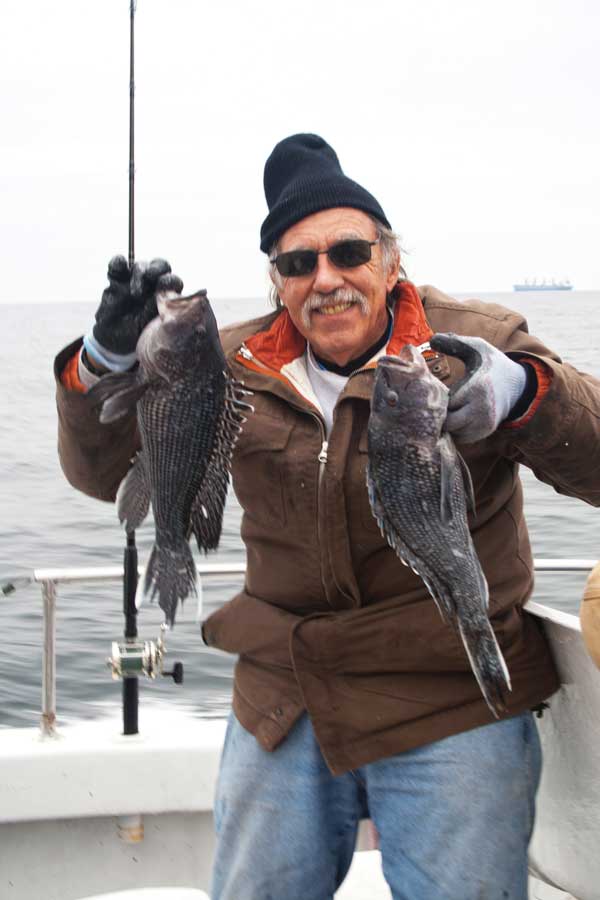The black sea bass fishing season runs until December 31 in Delaware, Maryland, and Virginia, and anglers are allowed to keep 15 fish that measure at least 12.5 inches. Fortunately, there seem to be plenty of black sea bass off the coast of all three jurisdictions, so we should be able to stock up our freezers for the winter.

Black sea bass are structure-oriented fish. They live on wrecks, reefs, and rough bottom and feed on crabs, worms, and anything they can find. If you want to catch them, you have to go where they live and that means finding the hard structure.
In recent years the state of Delaware has built several ocean reef sites. These begin inside the Three-Mile-Limit and run out into the Exclusive-Economic-Zone. The farther out you go the better chance you have of finding keeper sea bass. The coordinates of the Delaware reef sites are available free to the public.
Maryland does not have a state-sponsored reef program in the ocean. They do have a private reef program that requires membership in the program to receive the locations of the reefs.
Virginia also has a state-sponsored reef program with most of the ocean reefs placed close to the Chesapeake Light Tower. These locations are also free to the public.
In addition to the reefs, there are numerous wrecks and hard bottom locations that hold black sea bass. These locations are available from several sources; I use Captain Segull’s Charts.
It’s one thing to find the reef or wreck, but how you decide to fish it will be two completely different things. Some anglers like to drift the structure while others prefer to anchor. If I am on your boat, I like to anchor, but on my boat we will drift. Dropping and pulling up an anchor has become a bit more work than my old body can handle.
Anchoring has two methods. The first requires setting the anchor above the structure and going back on the rode until the boat is over the spot. The second uses a wreck anchor that hooks directly to the wreck and has the boat sitting right on top of the target. Because of the very short rode when using a wreck anchor, be very careful in even moderate seas.
When drifting a wreck, mark the target with a float and then drift by it as you work your bait or lure across the bottom. Drifting will eat up more rigs and lures than anchoring.
I have two outfits that I use when fishing for black sea bass. The first is brand new and is made by Tsunami. It’s a Forged TSFOR8LD-SI reel on a Trophy Series TSSPJ-C701H rod. It is a slow pitch rod and reel that I use with metal jigs. The second, also from Tsunami, is a bit more conventional one that I use when bait fishing. It’s a HYBRID 20 reel on a Classic TSCC 761H rod.
I find metal jigs work best on sea bass. Bucktails have too much water resistance and sink too slowly to be effective in the deeper water where sea bass live. A hairless jig with a piece of meat or one of the new FishBites Fight Club or Bob’s Your Uncle trailers should draw savage strikes. I used a Fight Club trailer on a recent trip to Virginia Beach and had hits from sea bass as soon as the jig hit bottom.
Generally, sea bass baits can be anything from squid to sand fleas. When caught, they spit up small crabs and tiny squids more than anything else. Sand eels are also on their diet. If I see sand eels, I switch to a thin metal lure right away.
The FishBites clam, bloodworm, and sand flea will work very well as sea bass bait. I have also had good luck with Gulp! peeler crab.
Fall weather can be a fickle lady. Sometimes it is better to take a head or charter boat to the sea bass grounds and leave the driving to them. There are several such boats running from Lewes, Indian River, Ocean City, and Virginia Beach.
If you choose a head boat, be sure to take a cooler large enough to hold your catch, yet small enough to fit under the seat along the rail. I always take two rod and reel outfits as well as plenty of rigs, lures, and sinkers. A good lunch, I take peanut butter and jelly, with plenty of water and some snacks should see you through the day.
By Eric Burnley